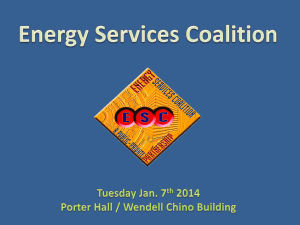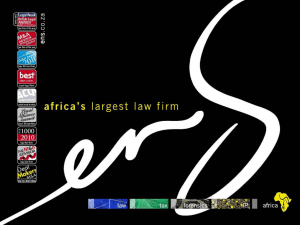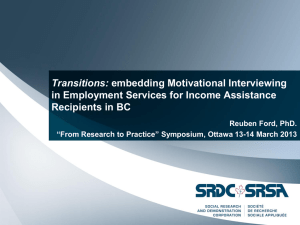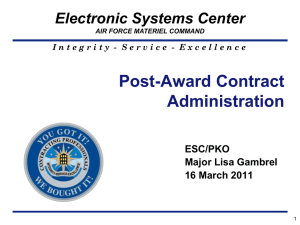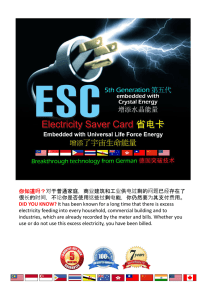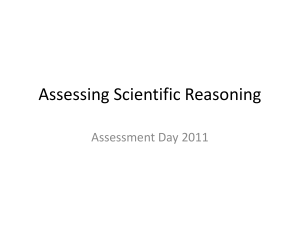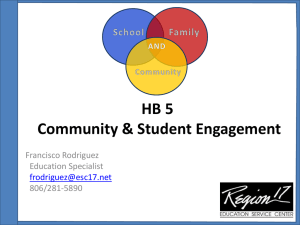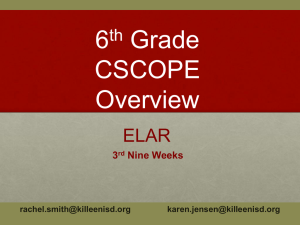Greenwave - St. Fintan`s National School Sutton
advertisement
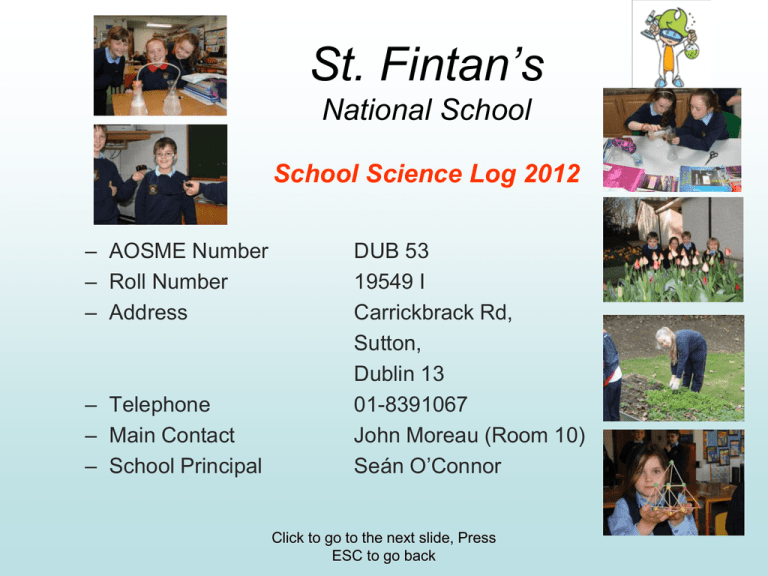
St. Fintan’s National School School Science Log 2012 – AOSME Number – Roll Number – Address – Telephone – Main Contact – School Principal DUB 53 19549 I Carrickbrack Rd, Sutton, Dublin 13 01-8391067 John Moreau (Room 10) Seán O’Connor Click to go to the next slide, Press ESC to go back This is St. Fintan’s 5th application for an Award of Science Excellence A key goal during this year’s AOSME was to involve every one of the 15 classes in the school from Junior Infants to 6th class.We just about managed to achieve that! Click to go to the next slide, Press ESC to go back The emphasis is on learning about science through experimentation, observation and fun! Click to go to the next slide, Press ESC to go back Some self-assessment • • • • • • Including all classes instead of the usual three or four was doable, but demanding. It did, however, broaden the reach of the Discover Science Program into the school. We were much too late starting into the Greenwave programme, and this will need much more effort in future. Next year we propose to get moving with Greenwave much earlier. The infant vegetable patch, was the most successful component of our AOSE program this year. 4th class exhibited at the Young Scientist and Technology and exhibition this year. This was the youngest class we’ve ever entered, but with enormous parental backup, it was a fantastic day and very worthwhile. The maths integration activities are another area where we need to do more formal planning. Two items in this Science log such as the visiting fisherman and the school vegetable patch are stretching the rules a little, but they are only included as supplementary items. We’ve tried to be as faithful to the AOSME requirements as we could. Click to go to the next slide, Press ESC to go back •And now for the serious stuff…. Click to go to the next slide, Press ESC to go back St. Fintan’s National School Discover Science and Maths Award Submission for 2012 1. 2. 3. 4. 5. Category 1: Prescribed Activities/GreenWave Category 2: Visiting Scientists/Field Trip Category 3: Young Scientists Exhibition Category 4: Maths & Science Integration Category 5: Science Week related Activities Click to go to the next slide, Press ESC to go back CATEGORY 1 Greenwave and actvities relating to the Forces and Energy Strand! Click to go to the next slide, Press ESC to go back Greenwave/Forces & Energy Index 1. Insulators and Conductors (3rd Class, Ms. O’Reilly) 2. Floating, Sinking, Buoyancy and the Dancing Raisins (3rd Class, Ms. Tarbett) 3. Creating a Vortex and an Airlock (4th Class, Mr. Moreau & 3rd class Ms. O’Reilly) 4. Amazing Triangles (1st Class, Mr. McGetterick) 5. Greenwave activities (6th Class, Mr. McInerney) Click to go to the next slide, Press ESC to go back Conductors and Insulators (1) • In this experiment the children initially explored the simple circuit. • They then used their simple circuits to test a number of items to see if the items were insulators or conductors in electrical terms. • This experiment was carried out by Ms. O’Reilly’s 3rd class. Click to go to the next slide, Press ESC to go back Conductors and Insulators(2) • The first day of the lesson involved the children studying the simple electrical circuit. A challenge that we do every year is to ask the children to make a circuit using the minimum number of components. Click to go to the next slide, Press ESC to go back Conductors and Insulators(3) During the second day of the lesson, the children explore the concept of conduction and insulation. Each pair brings to school a list of items such as golf tees, match sticks, food tins, paperclips etc. We use the simple circuit to test which of these are conductors and which are insulators. Click to go to the next slide, Press ESC to go back Conductors and Insulators(4) • At the end of the lesson, the children get to explore the insulation/conduction characteristics of lots of unusual items !!! Click to go to the next slide, Press ESC to go back Floating and Sinking (1) • Ms Tarbett’s 3rd class spent two long lessons investigating the buoyancy properties of objects. They made some unusual findings! Click to go to the next slide, Press ESC to go back Floating and Sinking (2) • The size of the object you were testing didn’t matter. It was what the object was made of. So, the tiny stone and paperclip sank, but the large candles and wood blocks floated. Click to go to the next slide, Press ESC to go back Floating and Sinking (3) The serious fun started when we dicovered that a citrus fruit floats, but when you peel it, it sinks. We decided the peel must be like a sort of lifejacket! We guessed there might be air bubbles inside the peel to help it float. Click to go to the next slide, Press ESC to go back Floating and Sinking (4) Zac suggested making a lifejacket for a metal screw to help it float. And it worked!!! Click to go to the next slide, Press ESC to go back Floating and Sinking (5) We completed the activity by doing the “Dancing Raisins” activity from the DPS website. More fun by observing and learning! Click to go to the next slide, Press ESC to go back Airlocks and Vortices (1) • This was a simple experiment, although the making took quite some time. The idea came to us from the Waterford IT stand at the BT Young Scientist Exhibition. • We purchased 30 “Vortex tubes” from a supplier and then the fun began. Click to go to the next slide, Press ESC to go back Airlocks and Vortices (2) The basic idea is to connect two large plastic bottles with a vortex tube as shown. One of the bottles is half full of water. It took several days of trial and error to realise the seal between the vortex tube and the bottles is vital. The only way to get a perfect seal was to use “Plumber’s tape” which you can buy at a hardware for a few Euro Click to go to the next slide, Press ESC to go back Airlocks and Vortices (3) • If the seals are perfectly air tight, when you turn place the bottle with the water on top, as shown, the water cannot fall down, as there is a airlock created. The air below simply has no escape! Click to go to the next slide, Press ESC to go back Airlocks and Vortices (4) So the only way to “release” the air, is to spin the top bottle which creates a vortex or whirlpool as shown. Once a vortex is created the air below can escape up the middle of the vortex. Click to go to the next slide, Press ESC to go back Airlocks and Vortices (5) We spent a long time discussing vortices in nature, i.e. natural whirlpools or tornados. Overall this experiment was lightweight in terms of discovery based science, but it was a lot of fun in terms of making, doing and observing. Click to go to the next slide, Press ESC to go back Airlocks and Vortices (6) Click to go to the next slide, Press ESC to go back Airlocks and Vortices (7) Recently we’ve been discussing Titanic because of the 100 year anniversary. It’s been said, but never fully proven, that a vortex created by the sinking ship sucked down many of the passengers with it. Click to go to the next slide, Press ESC to go back Amazing Triangles(1) The Amazing Triangles is something of a favourite of Mr McGetterick. The opposite photo was taken last year!!! Click to go to the next slide, Press ESC to go back Amazing Triangles(2) 1. 2. 3. This year, Mr McGetterick’s 1st class began this lesson by studying, on the whiteboard, photos of the Eiffel tower. By observation the children noted that the shape most commonly observed was the triangle. This fact was key to the maths integration later. Click to go to the next slide, Press ESC to go back Amazing Triangles(3) •Then we settled down to work constructing triangular pyramids. •We took breaks to discuss the triangular faces of the pyramid and the difference between 2D and 3D shape, as appropriate to the class level. Click to go to the next slide, Press ESC to go back Amazing Triangles(4) Click to go to the next slide, Press ESC to go back Greenwave (1) •Unfortunately we were late getting the Greenwave part of the AOSME going. •However, by now we’ve established a rota of 5th and 6th class children who take a daily temperature reading from our Greenwave thermometer, which is located in a porch at the top of the school. • Readings are taken daily at midday. •The average temperature is computed weekly by the pupils themselves and then entered on the Greenwave website. Click to go to the next slide, Press ESC to go back Greenwave (2) •In terms of observation, 4th class kept an eye on the two hazel trees beside the bicycle shed. •On March 26th we reported the new leaves on the Greenwave website. Click to go to the next slide, Press ESC to go back CATEGORY 2 Field Trips and Visiting “Scientist” 1. 2. 3. Field Trip to Botanic Gardens (4th Class) Night Time trip to Dunsink Observatory (3rd and 4th Classes) Visiting Fisherman, Sean Doran (4th classes) Click to go to the next slide, Press ESC to go back Field Trip to the Botanic Gardens(1) • On September 12th, Mr. Moreau’s 4th class had a wonderful field trip to the Botanic Gardens in Glasnevin. • Trip report follows… Click to go to the next slide, Press ESC to go back Field Trip to the Botanic Gardens(2) Trip Report by Sam Crawford: • • • • • • • • Today we visited the National Botanic Gardens in Glasnevin. The gardens are open to everyone, free of charge. The Botanic Gardens conserve many endangered plants and have six species of plant that are extinct! Our guide for the day was called Martina. She led us around the gardens and told us about the different plants. When we arrived we went into the Maize Maze, that was made of wheat and corn. I found it a bit disappointing because it wasn’t as dense and tall as I thought it would be. The Botanic gardens have many interesting trees including the Giant Sequoia, and the California Redwood, the tallest trees in the world. There was also a Cork Oak that had a very twisted bark. The Cork Oak is usually found in Spain, Portugal and California. I liked the Asian Gingko tree because it dates from the Jurassic period. The Botanic Gardens have an impressive collection of greenhouses. The greenhouses are temperature controlled and have special sprinklers. The main glass house is the Giant Palm House; it houses the poisonous Jade Vine and the Banana Plant. We went to the vegetable patch where we had a vegetable hunt to try to find 20 different varieties of vegetable. There were parsnips, pumpkins, cabbage and lots more. During our visit we saw the “Sculptures in Context” exhibition, Ireland’s largest outdoor exhibition. It was an interesting and fun day. Click to go to the next slide, Press ESC to go back Night-time trip to the Dunsink Observatory (1) Click to go to the next slide, Press ESC to go back Night-time trip to the Dunsink Observatory (2) • • • This year Sorcha Kavanagh, Mum of Alanah in 3rd class child bumped into a past pupil of our school, Gráinne Costigan(see picture), who works for the Dublin Institute of Advanced Studies, who run the Dunsink Observatory. Gráinne invited the 3rd and 4th class boys and girls, along with their parents to a night time visit to the observatory. The trip was originally scheduled for May 2011, but disaster struck when the observatory was closed by the Irish Army as a security precaution for Queen Elizabeth’s visit!! However, all was not lost and the field trip went ahead on October 25th, 2012. Click to go to the next slide, Press ESC to go back Night-time trip to the Dunsink Observatory (3) From the St. Fintan’s NS School Newsletter : Advanced Studies At Dunsink Observatory. Recently, 3rd (Ms. Tarbett) and 4th class(Mr. Moreau) had a wonderful night-time trip to the Dunsink Observatory. The trip was hosted by the Dublin Institute of Advanced Studies, who have owned and operated the observatory since the 1930's. The trip was organised by Sorcha Kavanagh (Mum of Alannah Greaves in 3rd class) and Gráinne Costigan, a researcher at the institute and also a past pupil of St. Fintan's NS. The trip was open to parents and children alike, with a substantial number of parents attending on the evening. The evening began at 730pm in the beautiful surroundings of Dunsink with a talk by Paul Dawson on the history of the observatory and the great scientists that worked there. This was followed by a presentation by Gráinne Costigan on how starts are formed. Finally there was another talk for the children on the planets in Earth's solar system. The evening concluded with a tour of the famous South Dome, home to the Grubb Telescope. For a time in the 19th century, this was the largest telescope in the world! The children, parents and teachers would like to thank Gráinne, Paul and the staff at the Dublin Institute of Advanced Studies for the welcome we received and the enormous efforts they went to, to make the subject accessible and interesting for the children. We’d also like to thank Sorcha Kavanagh for taking on the organisation and planning of the trip. It was a fascinating evening for young, and not so young, learners alike! Click to go to the next slide, Press ESC to go back Visit by Fishmonger Seán Doran(1) Click to go to the next slide, Press ESC to go back Visit by Fishmonger Seán Doran(2) Fish monger and former fisherman Seán Doran, of Doran’s on the Pier came into 4th class in November to make a presentation to the children on: – Different species of fish – Different methods for catching fish – Samples for tasting of many fish – The health benefits of seafood Click to go to the next slide, Press ESC to go back Visit by Fishmonger Seán Doran(3) Fish monger and former fisherman Seán Doran, of Doran’s on the Pier came into 4th class in November to make a presentation to the children on: – Different species of fish – Different methods for catching fish – Samples for tasting of many fish – The health benefits of seafood Click to go to the next slide, Press ESC to go back Visit by Fishmonger Seán Doran(4) Report by Jack Murray (Note: Jack’s Mum Eleanor organised the visit!) • • • • • Yesterday afternoon (27/10/11) we had a very special talk about fish presented by Seán Doran. Seán is a very nice man and he told us about fish like Shellfish = Scallops, Mussels & Octopus Redfish = Salmon and Trout Flatfish = Plaice and Sole Oily Fish = Sardines and Mackerel Large Oily Fish = Swordfish and Tuna Whitefish = Cod and Haddock Seán also told us about trawling which is actually another word for fishing. There are different nets to catch different species of fish. Also, baby fish should be able to escape but not always. There are different methods to trawling. There are nets that are round as a purse and others that aren’t a net at all. Some boats have to drag their nets deep, others at medium depths and others just at the surface. He showed us examples of different fish like: Salmon, Sea Bass, Mackerel, Sole and Plaice, Cod, Haddock, Prawns and Mussels. Finally Eleanor (aka my mum!) passed out taste testers of certain fish like salmon etc for us to eat. Afterwards we were given posters to place stickers onto once we ate certain fish at Doran's on the Pier.I thought it was a great afternoon. Click to go to the next slide, Press ESC to go back CATEGORY 3 The Young Scientists Exhibition, 2012 Click to go to the next slide, Press ESC to go back Young Scientists Exhibition, 2012(1) • • • The Primary Science Fair is a non-competitive science show that takes place at the BT Young Scientist Exhibition each year in the RDS. The Young Scientist project is a key part of the science program at St. Fintan’s NS and In 2012, we participated for the 9th successive year !! What makes the Primary Science Fair special is that it allows the class to explain in public their science project. Every year, it is often the “quieter” children who shine in their ability to explain their work to total strangers! Click to go to the next slide, Press ESC to go back Young Scientists Exhibition, 2012(2) 1. 2. 3. The title of this year’s project was studying yeast. The class studied what foods yeast likes to eat (e.g. sugar, flour, honey etc) and what conditions yeast likes best. We also analysed the gas produced when yeast eats! We “discovered” it’s CO2. Full report of the day at the RDS follows….. Click to go to the next slide, Press ESC to go back Young Scientists Exhibition, 2012(3) A report of my day at the RDS by Mimi Cuddy. • • • • • • • • • Last Saturday, January 14th, 4th class from St. Fintan’s entered the Young Scientist Exhibition. Our class was split in to the morning and afternoon shifts. I was in the afternoon. Our project was called Experimenting with Yeast. There were a lot of primary schools in our section. Each person in our group spent about an hour and a half on our stand explaining our project about yeast. When we were off the stand, we were allowed to visit other exhibits. I loved our project and our teacher worked very hard with us. Thank You. My favourite stand was the RTE stand. You got to play around with reading the Weather Forecast. The experience was the best time of my life!! Click to go to the next slide, Press ESC to go back Young Scientists Exhibition, 2012(4) Click to go to the next slide, Press ESC to go back Young Scientists Exhibition, 2012(5) James, Charlie and Sam were interviewed on the radio about our Yeast Project !!!!!!!!!! Click to go to the next slide, Press ESC to go back CATEGORY 4 Maths Integration Click to go to the next slide, Press ESC to go back Maths Integration • The following slides show three examples of Maths integration during Science lessons. These are: 1. 2D/3D Shape 2. Averages 3. Measurement (Amazing Triangles experiment) (Computing Average temperature over a week (Greenwave)) (Measuring depth for potato planting) Click to go to the next slide, Press ESC to go back Maths Integration 1 3-d Shapes • During the Amazing Triangles experiment (Category 1), 1st class revisited some 2-D and 3-D shapes work done in Maths class. • We used the pyramids to observe that the faces of 3D shapes are in fact 2D shapes. • We also revisied some basic facts about triangles, as per the 1st class curriculum. Click to go to the next slide, Press ESC to go back Maths Integration 2 Computing Average Weekly Temperature. • We’re now recording daily temperatures at 12pm in the school. • On Fridays Morgan, Carla and Kevin from Ms. Furlong’s 5th class work out the average temperature for the week to 1 decimal place. • NO CALCULATORS ALLOWED !!!!!!!! Click to go to the next slide, Press ESC to go back Maths Integration 3 Measuring length when potato planting. • When the infant classes were potato planting recently we used a nonstandard measure of length (as per curriculum) which was roughly equal to the 4inch depth to which the potatoes should be planted. Click to go to the next slide, Press ESC to go back Maths Integration 3 Measuring length when potato planting. • Other examples of measuring the planting depth using non-standard units with the infant classes. Click to go to the next slide, Press ESC to go back CATEGORY 5 Science-week activities 1. Filtering water for human use as part of the water cycle(Ms. Furlong’s 5th class) 2. Exploring Alkalis and Bases (Ms. McGinn’s 5th class) 3. Growing food and flowers in the new school vegetable patch (All 4 Infant classes) Click to go to the next slide, Press ESC to go back Filtering Water (1) • Ms Furlong’s 5th class had already studied the basic idea behind the water cycle, when they then undertook and experiment in filtering dirty water. The idea is to mimic the filtration process that Dublin’s Liffey water undergoes before it is piped into people homes. Click to go to the next slide, Press ESC to go back Filtering Water (2) Step 1: Constructing Filters Click to go to the next slide, Press ESC to go back Filtering Water (2) Step 2: Making “Dirty Water” Click to go to the next slide, Press ESC to go back Filtering Water (3) Step 3: Filtration Click to go to the next slide, Press ESC to go back Filtering Water (4) Comparing results Click to go to the next slide, Press ESC to go back Alkalis and Bases(1) • • This experiment is a Ms. McGinn special. Most older classes in her charge enjoy this activity. This year was no exception. However, as can happen the photos of the experiment as conducted by the current 5th class have been accidentally deleted. We’ve enclosed a report written by two fifth class boys, Scott and Alan , as evidence of work carried out. Opposite are two photos of the experiment as carried out by last year’s 6th class! Click to go to the next slide, Press ESC to go back Alkalis and Bases(2) Science Report on Acids and Bases by Scott Bastow and Alan Keogan Many acids and bases are sitting in your kitchen cupboards. Acid are corrosive and bases are caustic, and if they are used incorrectly they could be dangerous and cause a lot of damage. Experiment We made our own PH scale out of red cabbage water, we mixed the cabbage water in with some household items like, “Johnsons baby shampoo, normal shampoo, white wine, washing up liquid, bread soda, 7-up, lemon juice, tap water and vinegar”. Prediction We predicted that items would change colour when we put them into the red cabbage, and that there would be colours that meant whether the item was an acid or a base. Materials Red cabbage, hot water, 10 x jars, knife, milk carton 2lt, sieve and a jug. Method (1.We used the knife to cut up the cabbage.(2. Then we used the hot water to make the red cabbage into juice.(3. We put the items into the red cabbage juice and watched the reactions take place. The results : Red / pink = acid Blue / green / yellow = base White wine = pink Washing up liquid = red Bread soda = blue Normal shampoo = pink Baby shampoo = red Lemon juice = red 7-up = pink Vinegar = red Tap water = blue Click to go to the next slide, Press ESC to go back Alkalis and Bases(2) Alan and Scott’s Copybooks Click to go to the next slide, Press ESC to go back School Vegetable Patch(1) • The school vegetable patch was inaugurated last May. We’re starting off small with 4 raised beds, one for each of the infant classes. We hope to grow vegetables and flowers for as much of the year as we can. To date we’ve grown Onions, Tulips, Daffodils and Wallflowers. Only recently the daffodil and tulip bulbs were “harvested” to make way for early potatoes. Click to go to the next slide, Press ESC to go back School Vegetable Patch (2) (Spring flowers and bulbs) Click to go to the next slide, Press ESC to go back School Vegetable Patch (3) (Harvesting daffodils to make way for early potatoes) Click to go to the next slide, Press ESC to go back School Vegetable Patch (4) Weeding is an important part of gardening, but we’ve always got lots of help! Click to go to the next slide, Press ESC to go back School Vegetable Patch (5) Shane and Dan “Chitted” the potato seed ready for planting by the Senior Infant Classes. (Note: This means removing all but one healthy stalk from the seed potato) Click to go to the next slide, Press ESC to go back School Vegetable Patch (6) Potato planting, April, 2012 Click to go to the next slide, Press ESC to go back
